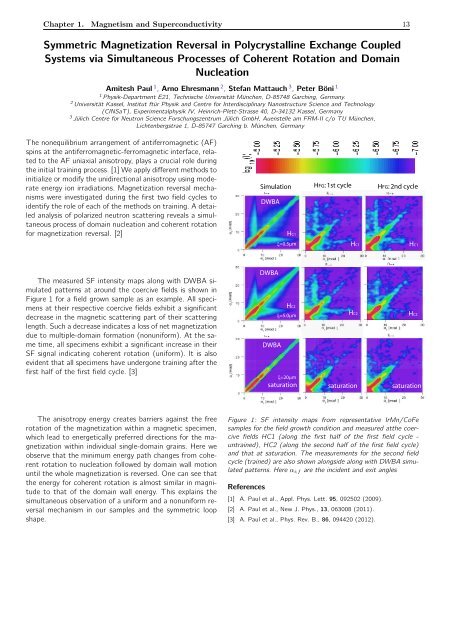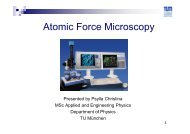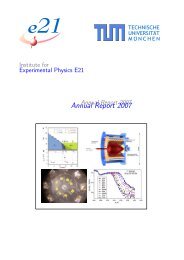Annual Report 2011 / 2012 - E21 - Technische Universität München
Annual Report 2011 / 2012 - E21 - Technische Universität München
Annual Report 2011 / 2012 - E21 - Technische Universität München
Create successful ePaper yourself
Turn your PDF publications into a flip-book with our unique Google optimized e-Paper software.
Chapter 1. Magnetism and Superconductivity 13<br />
Symmetric Magnetization Reversal in Polycrystalline Exchange Coupled<br />
Systems via Simultaneous Processes of Coherent Rotation and Domain<br />
Nucleation<br />
Amitesh Paul 1 , Arno Ehresmann 2 , Stefan Mattauch 3 , Peter Böni 1<br />
1 Physik-Department <strong>E21</strong>, <strong>Technische</strong> Universität München, D-85748 Garching, Germany.<br />
2 Universität Kassel, Institut ftür Physik and Centre for Interdisciplinary Nanostructure Science and Technology<br />
(CINSaT), Experimentalphysik IV, Heinrich-Plett-Strasse 40, D-34132 Kassel, Germany<br />
3 Jülich Centre for Neutron Science Forschungszentrum Jülich GmbH, Auenstelle am FRM-II c/o TU München,<br />
Lichtenbergstrae 1, D-85747 Garching b. München, Germany<br />
The nonequilibrium arrangement of antiferromagnetic (AF)<br />
spins at the antiferromagnetic-ferromagnetic interface, related<br />
to the AF uniaxial anisotropy, plays a crucial role during<br />
the initial training process. [1] We apply different methods to<br />
initialize or modify the unidirectional anisotropy using moderate<br />
energy ion irradiations. Magnetization reversal mechanisms<br />
were investigated during the first two field cycles to<br />
identify the role of each of the methods on training. A detailed<br />
analysis of polarized neutron scattering reveals a simultaneous<br />
process of domain nucleation and coherent rotation<br />
for magnetization reversal. [2]<br />
Simulation<br />
DWBA<br />
HC1<br />
HFG:1stcycle<br />
HFG:2ndcycle<br />
ξ=0.5µm<br />
HC1<br />
HC1<br />
The measured SF intensity maps along with DWBA simulated<br />
patterns at around the coercive fields is shown in<br />
Figure 1 for a field grown sample as an example. All specimens<br />
at their respective coercive fields exhibit a significant<br />
decrease in the magnetic scattering part of their scattering<br />
length. Such a decrease indicates a loss of net magnetization<br />
due to multiple-domain formation (nonuniform). At the same<br />
time, all specimens exhibit a significant increase in their<br />
SF signal indicating coherent rotation (uniform). It is also<br />
evident that all specimens have undergone training after the<br />
first half of the first field cycle. [3]<br />
DWBA<br />
DWBA<br />
HC2<br />
ξ=5.0µm<br />
ξ=20µm<br />
saturation<br />
HC2<br />
saturation<br />
HC2<br />
saturation<br />
The anisotropy energy creates barriers against the free<br />
rotation of the magnetization within a magnetic specimen,<br />
which lead to energetically preferred directions for the magnetization<br />
within individual single-domain grains. Here we<br />
observe that the minimum energy path changes from coherent<br />
rotation to nucleation followed by domain wall motion<br />
until the whole magnetization is reversed. One can see that<br />
the energy for coherent rotation is almost similar in magnitude<br />
to that of the domain wall energy. This explains the<br />
simultaneous observation of a uniform and a nonuniform reversal<br />
mechanism in our samples and the symmetric loop<br />
shape.<br />
Figure 1: SF intensity maps from representative IrMn/CoFe<br />
samples for the field growth condition and measured atthe coercive<br />
fields HC1 (along the first half of the first field cycle -<br />
untrained), HC2 (along the second half of the first field cycle)<br />
and that at saturation. The measurements for the second field<br />
cycle (trained) are also shown alongside along with DWBA simulated<br />
patterns. Here α i;f are the incident and exit angles<br />
References<br />
[1] A. Paul et al., Appl. Phys. Lett. 95, 092502 (2009).<br />
[2] A. Paul et al., New J. Phys., 13, 063008 (<strong>2011</strong>).<br />
[3] A. Paul et al., Phys. Rev. B., 86, 094420 (<strong>2012</strong>).




